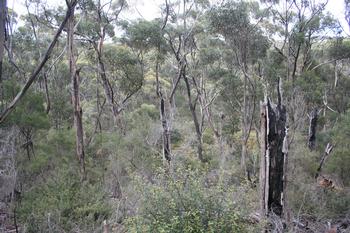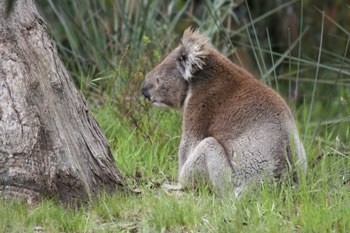| A | U | S | T | R | A | L | I | A | 2 |
0 |
0 |
5 |
 |
 |
 |
 |
Total: 1120 |
Oct 28 |
 |
Ravine des Casoars-Koala-Adelaide
|
|
|
|
|
Ravine Des Casoars Hike—The walking track is approximately four kilometers long (8 km return—allow 4 hours), and passes through low mallee vegetation before reaching a panoramic viewpoint. The trail then descends steeply to a small creek, before opening onto a narrow, sandy beach. Follow the signs from the start of the walk. It is a ring route which traverses the river bed to the sea and return. The beach is flanked by low limestone cliffs, which have been constantly exposed to wind and waves. Large caves have been formed, which are home to numerous little (fairy) penguins. The trail is steep in sections and is rocky and uneven. The hike begins on the Ravine Road, 7km S of the Playford Highway, near Cape Borda. Please note the sea cave on the beachfront is not open for public access. |
||
A couple of miles down the road is a turn off that leads to a walk which was recommended by the Park Service staff. After another five miles or so, the dirt roads ends in a small parking lot. An information board implies that there's a five mile circular route down to the coast (and an apparently famous sea cave) and back, and that is it rugged, so should only be attempted by experienced hikers. Naturally, we assume they mean us, even though we lack the expertise to find both of the paths) so we take the one we can find. The trail is called Ravine des Casoars and while it is certainly attractive, to call it a Ravine is a bit of an exaggeration.
It is a beautiful mid-70's kind of day, and we don't have a lot on the agenda after our action-packed day yesterday, so when we stop for our usual lunch of a long black and meat pie at a bakery in the one-horse town of Pardana, we decide to sit and eat them right there, since the bakery has kindly provided tables and chairs for that purpose in a little patio separating their front door from the street.
As we are sitting there, a koala strolls across the road in front of us. We grab the cameras, and follow him to a nearby eucalyptus which he climbed so we could get the classic 'in the crook' shots. |
 |
Eastward Ho. In her zeal to show us everything in the store, the assistant in the Eucalyptus Distillery made us try some sort of lotion, and over the last 24 hours we've grown fond of the smell. We divert to pass the store again. Inside the store three or four people are crowded around a two foot high wallaby, scratching its chest and stroking its ears. Amazingly, it is completely free—several times I see it hop out of the store with one set of guests, and come back in again with another set a few minutes later. S/he is as soft as a lamb. Now that we've seen the Remarkables, the poster of them hanging on the wall seems a much more interesting bargain, and I take that along with the body lotion. On our final Sydney repack it occurs to us that we probably bought 80-90% of all our souvenirs in this one store. It was just the right blend of useful, hand- and locally-made, earth-friendly, and of course, price.
Back in the car, we still have time left so we invent another stop: the salt lake at Flour Cask Bay. Hopefully another shot at some of the missing shore birds. The lake seems to form the remains of an old gypsum mine. The place is flat, and white, and although there is still water in the lake, its only a couple of inches deep. The shore birds are conspicuously absent. Abandoned by both birds and man, the place has a rather lonely feel to it, thought there is still beauty in its quiet, stark, flatness.
The one thing that we've definitely missed here on KI is the pelicans, and though the "feeding time" attraction feels too commercialized for our tastes (and we're too late anyway), we figure the the Pelican Lagoon Conservation Park ought to have a few specimens. We're being pulled by the gravity of the ferry departure, so we don't venture too far in. We get a close encounter with a Pacific Gull, but we need the spotting scope to confirm a couple of pelicans.
We make good time to the ferry, and in fact would be in time for the earlier one. But there's no bus connection for this ferry, so instead we watch it pull away, and we spend the last of the light enjoying a couple of beers, watching plantaginates and perhaps penguins making their way home for the night. It is dark before the next ferry pulls away, and perched in my usual position out in the fresh air I watch the harbor lights recede to a twinkle.
Then the 70 mile bus ride from Cape Jervis back to Adelaide. It is a little after 10:30 when we finally pull in at the bus terminal. But it is less than ten minutes walk to the hotel, and we've checked in with the night porter, dumped our gear, washed our faces, changed our shirts and returned to the lobby before 11:00pm. The hotel is on Hinckley Street, as central as it can be. We step straight back into the nightlife we had waded through with our double packs 10 minutes earlier. It was clear that the Adelaide wildlife was not keen on having its photograph taken, so we've left the cameras in the hotel. Which is a pity, because there were some pretty interesting shots to be had.
We find a bar fairly close to home that isn't packed to the gunnels, and where we don't have to lean into the smoke and the music in order to make forward progress. But after we fumble for vocabulary with the first round and end up with something too small, we have to ask the women at the next table for a lesson. Turns out we need schooners (which are not the same measure here in Adelaide as they are in other parts of the country). We have a couple of these, but by then it's midnight, and we have another early start in the morning. And as yet, we haven't decided whether to head north or south out of the city.








